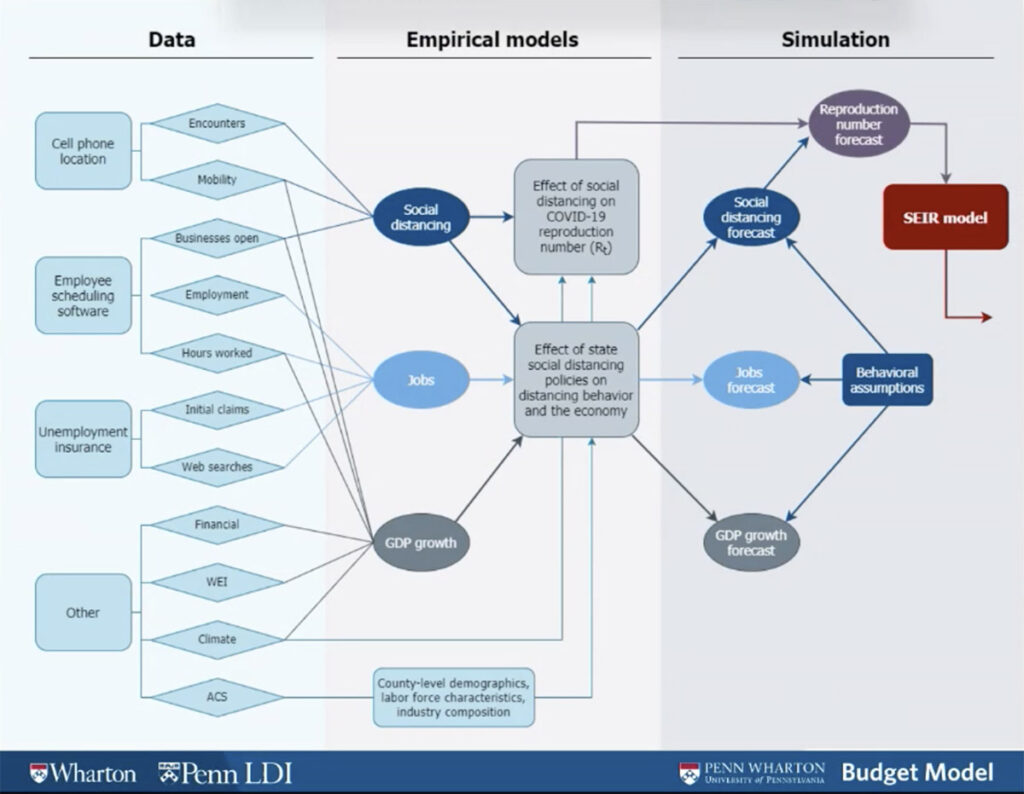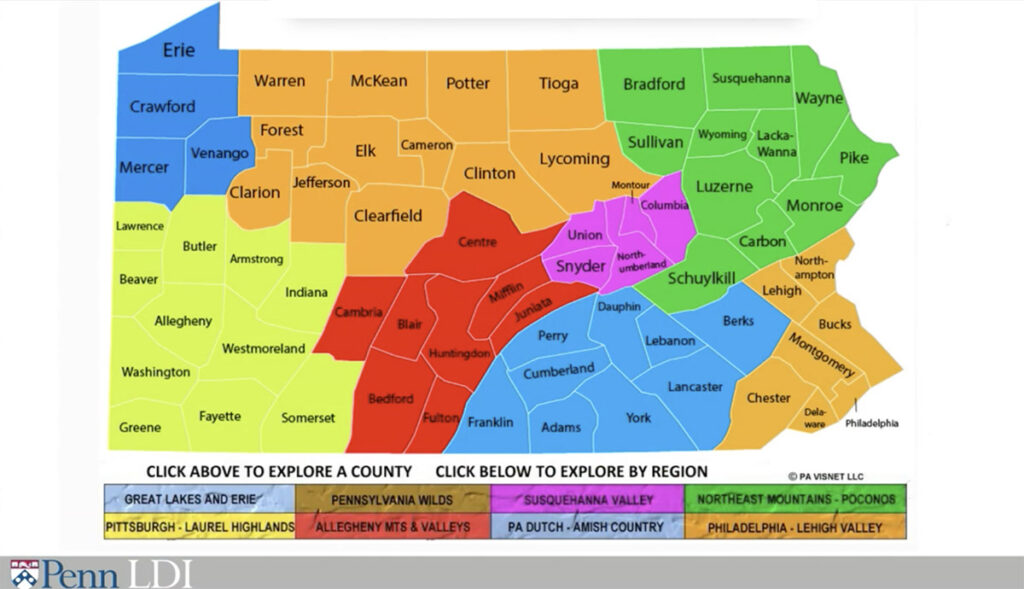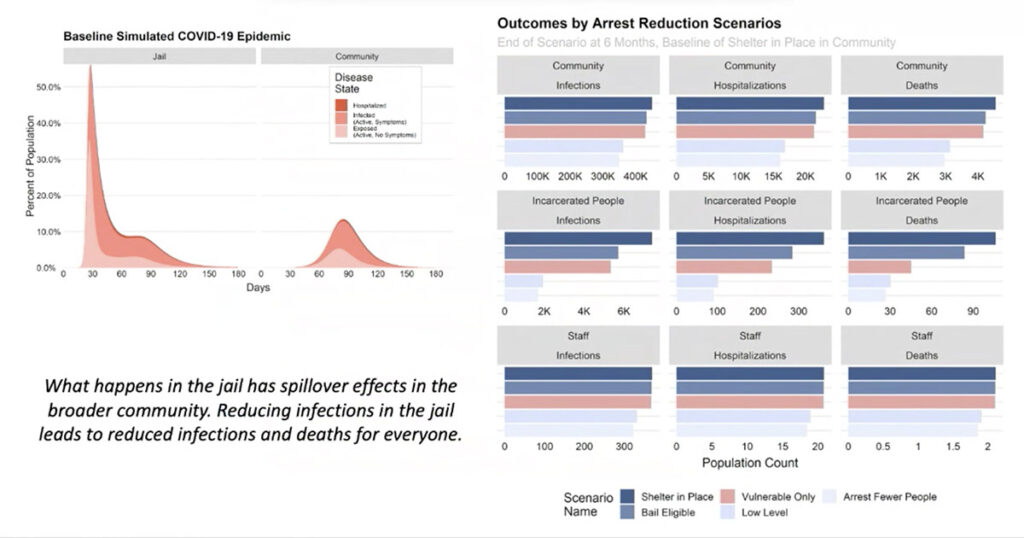News
Model Simulations Point to Key Concerns for Reopening the Economy
Penn Scientists Weigh In At Latest LDI Virtual Seminar
As two-thirds of the 50 states began relaxing their anti-COVID-19 restrictions, a May 15 virtual seminar convened by the University of Pennsylvania’s Leonard Davis Institute of Health Economics (LDI) brought together scientists who have created different simulator models to predict the economic and health changes various levels of policy relaxations may bring.
A primary goal of these teams’ research is to provide evidence-based insights to inform how a coherent national system of testing, test data aggregation and reporting, and contact tracing could be used to more accurately know and manage the true scale and daily dynamics of the contagion. This is of particular importance during the interim before effective treatments or vaccines are developed. On the economic side, the same scientific work is essential to informing the reestablishment of the consumer confidence necessary for national economic recovery.
At the sixth LDI virtual “Experts at Home” seminar, panelists discussed the insights and findings from their latest simulator updates. The theme of the session was “Are We Ready to Reopen the Economy?” and it couldn’t have been more timely.
Health vs. economics
On the same day, Philadelphia’s number of COVID deaths rose to 1,021. Texas reported 1,815 new cases — its single largest daily increase. At New Jersey shore towns, municipal officials were preparing for the following day’s reopening of boardwalks and beaches that attracted dense throngs of visitors, many of whom neither wore masks nor maintained six feet of social distancing. Additionally, during the same week, the U.S. Labor Department reported the COVID-driven unemployment total hit 36.5 million — the largest such loss in United States history.
“The work we’re discussing today is being done to inform some very, very difficult decisions that elected officials are facing today,” said seminar moderator David Grande, MD, MPA, LDI’s Director of Policy. “Governors around the country are really struggling to figure out appropriate next steps at the same time there are clear health and economic costs of different approaches that have immense implications for the American public.”
Big data simulations
The four panelists were from three different Penn projects that have constructed big data simulation models analyzing the spread and health impact of the disease, the related behavior of American consumers, and the economic impact of national, state and local measures designed to contain and mitigate the pandemic. The three models are the Penn Wharton Budget Model’s new Coronavirus Policy Response Simulator, PolicyLab at Children’s Hospital of Philadelphia’s COVID-Lab: Mapping COVID-19 in Your Community, and the ACLU COVID-19 Model created by the ACLU in collaboration with researchers from Penn, Washington State, and the University of Tennessee.

The Wharton School online simulation enables users to see how the interconnected numbers of COVID deaths and lost jobs change in three different policy scenarios — no policy change, partial relaxation of COVID social distancing measures, and total lifting of those measures. The changes are dramatic. In one case, maintaining all policies in effect on May 15 would result in 150,000 deaths nationally by June 15, but partial relaxation increased that to 285,371 deaths in the same period.
Impact of personal behavior
“It turns out that personal behavior matters tremendously in this,” explained Penn Wharton Budget Model Director Kent Smetters. “As people’s social distancing goes down you have fewer job losses but more deaths.” His point about the importance of social distancing was a matter of panel consensus.
“We’ve seen this in other countries,” continued Smetters, a Professor of Business Economics and Public Policy at the Wharton School and an LDI Senior Fellow. “In Hong Kong, for example. After partial reopening, there was a big change in personal behavior as people apparently took the policy change as a signal about risk factors and substantially lowered their own social distancing — which resulted in a resurgence of second-wave infections.”

The CHOP PolicyLab model is studying the relationship between climate and contagion. “We’re getting more and more confident about the temperature effects we’re seeing,” said PolicyLab Director, Penn Medicine Professor of Pediatrics and LDI Senior Fellow David Rubin, MD, MSCE. “There’s a question about whether it’s temperature or humidity or ultraviolet light, but we’ve got pretty good evidence from other respiratory viruses that respiratory transmission decreases as you get to hot and humid weather. Our team is fairly confident that we’re picking up a strong signal that temperature is involved, but not enough to mitigate transmission entirely.”
Climate vs. contagion
Rubin noted his team is not seeing the same explosive growth of the pandemic in the South as in Northeast and Midwest cities. He believes some of that may be related to climate. “When people go out to the beach, there’s some gathering evidence it’s not a risky maneuver in and of itself because of the UV and natural ventilation. So I’m not surprised by what’s going on in the South. Our models suggest the same thing.”
However, he also emphasized that a danger posed by the decline of respiratory viral infections in the summer is complacency. “If we have predictably normal-looking summers in many areas with very few COVID cases, people will think, ‘OK, let me take off that mask; I don’t need to wash my hands.”
Decline in social distancing
“We’re seeing that in real time now,” said Penn Wharton Budget Model Senior Analyst John Ricco. “Our daily activity indices show that. If we look state by state in the places that have eased some of their lockdown measures, and even places that haven’t, social distancing is declining pretty much across the board.”

While it’s well-known that nursing homes have been deadly hot spots of COVID-19 outbreaks, there is less appreciation for how the disease has similarly flashed through the country’s jails and prisons — a subject of panelist Kristian Lum‘s research work. Lum, PhD, is a Research Assistant Professor in the Department of Computer and Information Science at Penn’s School of Engineering and Applied Science, and a member of the ACLU/university collaboration studying coronavirus spread in jails and prisons.
Jails as community infection hubs
Her key point was that jails and prisons are particularly “porous” institutions where densely-packed inmates in facilities often lacking in personal protective equipment and even soap, easily transmit COVID-19 among themselves as well as the jail’s staff. She characterized some jails as hubs that foster the spread of high levels of contagion that is easily spread into the community by commuting staffers and prisoners who continuously move into and out of incarceration or travel back and forth for various courthouse appearances.
Lum’s model, based on local Pennsylvania jail data, painted a grim picture. “We found that within the jail, we end up with these raging outbreaks fairly early on,” she said. “If we shelter in place out in the community but do nothing in jail, the bar of infections, hospitalization and death is the highest for both. If we reduce infections in the jail, that leads to reductions in infections and deaths in the surrounding community.”
Model data bias
Lum also emphasized the importance of being aware of bias in model data. “In the beginning of the epidemic,” she said, “when testing was a lot less common, who was getting tested? If you were an NBA player or you had attended a Republican convention or you were Tom Hanks, you had no problem. But people who were even health care workers whose children had symptoms were having a lot of trouble getting a test. Those are the sorts of cases that don’t end up appearing in the data. If there is a population appearing less affected by the epidemic, especially when we’re relying on things like cases and positive testing, we have to think about how the tests are being distributed and who’s being ignored in all of this.”
In a presentation relevant to the current acrimonious political debate in Pennsylvania, PolicyLab’s Rubin displayed a map of the 24 state counties his team is monitoring; he noted how the disease burden across that broad swath of geography varies dramatically.
Dramatic differences across Pa.
“When we see someone from a rural area of Pennsylvania who is very upset that they can’t go back to work because they’re not seeing circulating COVID cases, they’re not wrong,” said Rubin. “But when we see someone from York or Philadelphia who has witnessed the tragedy of what’s going on there with COVID and can’t believe how anyone would protest a sheltering in place strategy, they’re not wrong either. It’s because of local area effects.”
“There’s a wall that forms around the southeast — the metro area of Philadelphia — and that is the high risk area,” Rubin continued. “As you go up into the Poconos, Luzerne county, where all those Philadelphians have their lake homes, has been some trouble, but then there’s much of the rest of the state where there’s been little activity. Our forecasts for those counties have been much more optimistic.”
Another issue the panelists are investigating is one of the most important questions of any effort to restart the economy and return tens of millions to work. It is this: if a governor DOES reopen all the stores, restaurants and sports and entertainment venues in a state, how likely is it that a majority of consumers will rush in to spend their money again?
Consumer behavior
“This is another area where personal behavior matters incredibly,” said Wharton’s Smetters. “Our analysis shows that (consumers’) behavior was changing before a lot of states began locking down because of their own safety concerns. Restaurant activities and lots of other activities were declining before there were any official policies. So, it’s actually not true that it’s policy that’s reducing economic activity.”
The bottom line appears to be that consumers’ enthusiastic return to the bricks and mortar retail marketplace will depend on how much they still fear contagion. Another consensus point among the panelists was that one of the keys to boosting consumer confidence again (aside from developing effective treatments and a vaccine) will be the nationwide existence of an easily accessible system of accurate COVID testing that we don’t yet have.